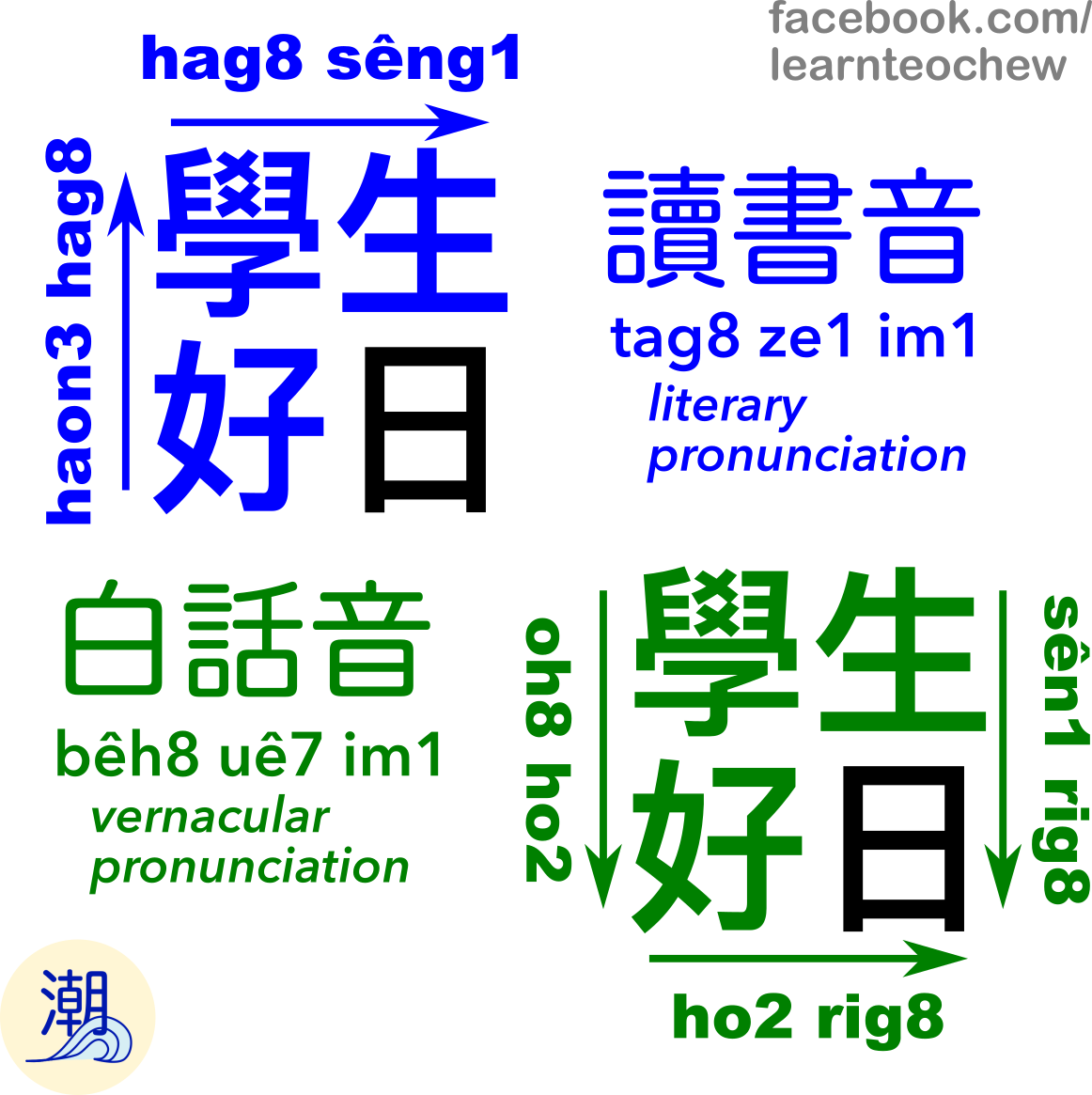Teochew literary reading (2) - Literary vs. vernacular readings
Many Chinese characters in Teochew have two different pronunciations, vernacular (白話音 bêh8uê7im1) and literary (讀書音 tag8ze1im1). This phenomenon also occurs in Mandarin, e.g. the name of the poet 李白 is pronounced Lǐ Bó, not Lǐ Bái, but is much more widespread in Southern Min languages like Teochew and Hokkien. This phenomenon of a character having different readings is known as 文白異讀 bhung5bêh8 i6tag8.

An example is the character 學. This is pronounced oh8 (vernacular) or hak8 (literary).
The vernacular reading is used most often in everyday speech:
lai5 oh8 Diê5ziu1-uê7 來 學 潮州話 • Come learn Teochew
Literary reading was traditionally used to recite classical texts:
dai7hag8 ze1 dao6, zai6 mêng5 mêng5dêg4 大學之道,在明明德 • “What the Great Learning teaches, is to illustrate illustrious virtue”
However some words, usually with a technical or literary origin, use the literary pronunciation of the characters even when spoken in everyday speech:
i1 si6 ua2-gai7 hak8sêng1 伊 是 我個 學生 • he/she is my student
And for certain words, some people may use the literary reading while others use the vernacular reading:
Suan1tao5 Dai7hag8 / Dua7oh8 汕頭 大學 • Swatow University
Is this confusing? The main reason for confusion is the misconception that characters = words. Traditional scholars understood that characters can represent more than one word (or reading), and they learned this by memorizing a lot of texts. When modern Mandarin was standardized, officials tried to minimize multiple readings, but some still remain, and are called 破音字 pòyīnzì (“split pronunciation words”) or 多音字 duōyīnzì (“many pronunciation words”).
Examples from Mandarin include:
還 - hái (“still”) vs. huán (“return”)
著 or 着 - zhe / zháo / zhúo / zhù / zhāo (!!)
Some of these pòyīnzì have been broken up in modern standard Mandarin (MSM) and simplified characters. For example, 那 previously represented both nà “there” and nǎ “where?”, but 哪 is now used for the question word instead. For 著/着, the 着 is now the standard in Simplified MSM for zhe / zháo / zhúo / zhāo, but 著 is used for zhù e.g. in the compound word 著名.
In comparison to Mandarin, where this affects a few words and characters here and there, characters with multiple readings are much more prevalent in Southern Min languages including Teochew and Hokkien, to the extent that the literary vs. vernacular readings have been called two parallel phonological systems in the same language. In Min languages, they represent different historical layers in the language.
Having such layers is not unique to Chinese languages. What is special is that the writing system of Chinese characters means that these different layers are all hidden under the same characters, presenting a puzzle that has to be deciphered.
An analogy to English: There are (at least) three words for “dog” in English: “dog” (origin unclear), “hound” (from Germanic), “canine” (from Latin). We use them in different contexts much like oh8 and hak8 in Teochew. For example: “dog-catcher”, “hound-racing”, “canine distemper”. Now imagine that they were all written as “dog”, but pronounced “dog”, “hound”, and “canine” depending on the context, but there is no way to write down the pronunciations, and that people call you ignorant and uneducated if you use the wrong one. That would be similar to the experience of schoolboys in traditional schools.
Next week, we’ll talk about where the different vernacular and literary readings come from. Here’s a hint: one is typically older than the other, can you guess which?
Posted on 2021-04-29 00:00:00 +0000